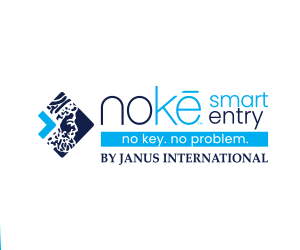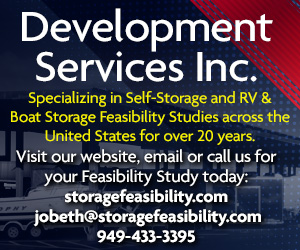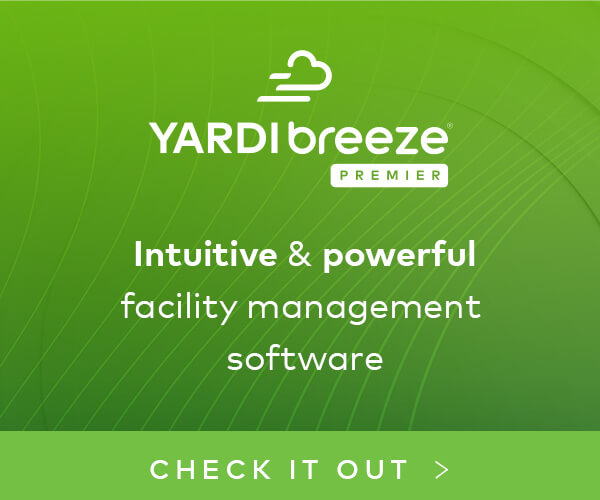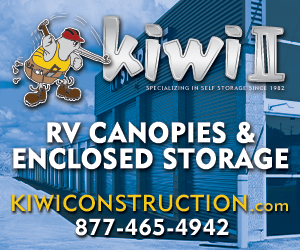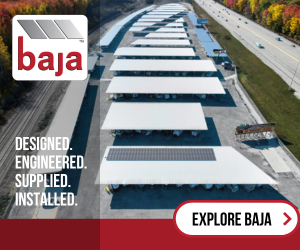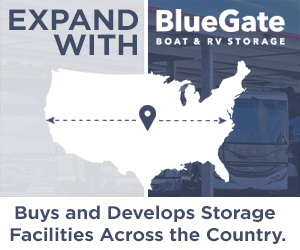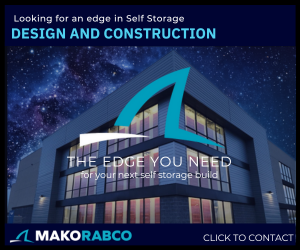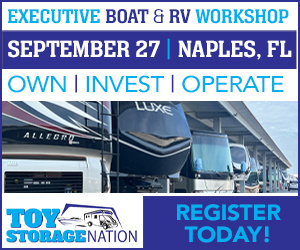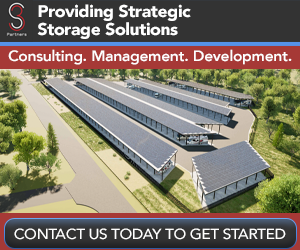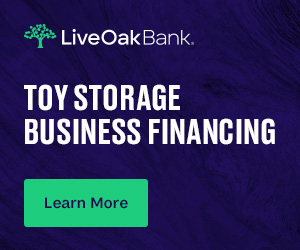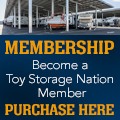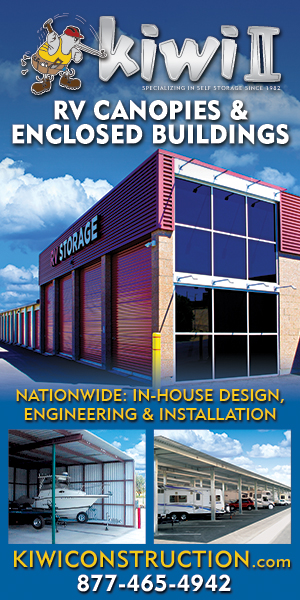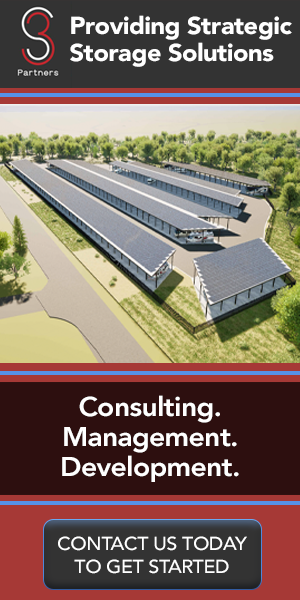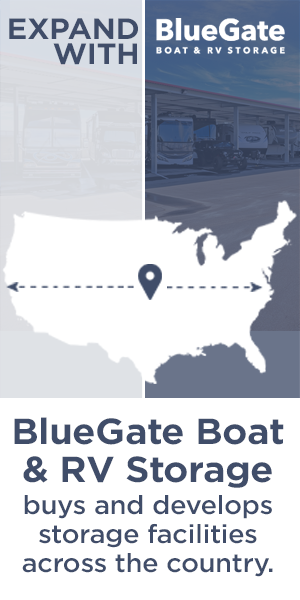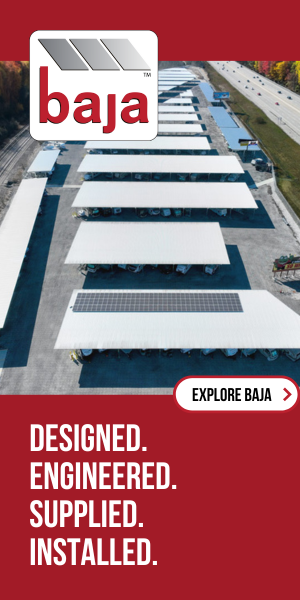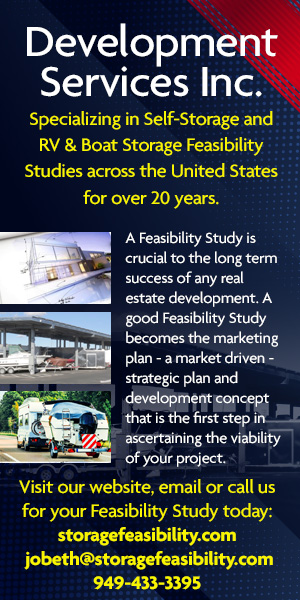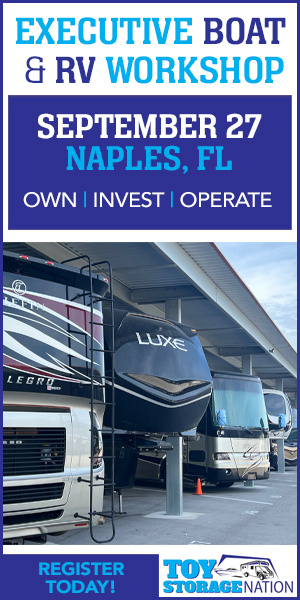Q&A With Amber Crucian of Live Oak Bank

Toy Storage Nation caught up with Amber to get a lending expert’s point of view on the toy storage industry and the current economy, especially pertaining to financing RV and boat storage development and acquisitions.
From your perspective, how is the current state of the economy impacting RV and boat storage development and acquisitions?
We have seen a lot more stabilization in the RV and boat market over the past year, as opposed to the boom that happened in the industry in 2020-2022 during and post-COVID. We are still seeing a lot of projects pencil out, but fewer projects cash flow at higher leverage. Despite interest rate pressure, we’re seeing a lot of great opportunities in more tertiary markets for both acquisitions and developments. The strength of the individual projects are driven by market rates, other new development (if applicable) and construction costs.
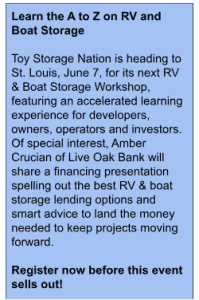
I think in some cases it makes sense – especially for projects that aren’t going to cashflow at where rates are today. However, in a lot of cases, interest rates are only one piece of the equation. How the debt is structured, termed out and amortized can be crucial to cashflow, interest rates aside.
It is also important to keep in mind that if you’re waiting for interest rates to simmer down, most likely others are as well. When I think about this question, my mind goes to the Warren Buffet quote, “Be fearful when others are greedy and be greedy when others are fearful.” There’s a lot to be said about the advantages of having to worry less about competition if you build now versus when rates do start to cool down and development planning starts to heat up.
What are some of the best loan options for toy storage developers?
There are lots of debt options out there, so it’s vital to do your research and decide which product type makes the most sense for your business, your project size/scope and you personally. Live Oak Bank primarily works with SBA 7(a), SBA 504 and Conventional bank loans.
SBA 7(a) is a great option for projects under $10 million in total costs, especially for those that are getting into the industry for the first time. Live Oak Bank is the No. 1 lender by dollar volume in the country for SBA 7(a) loans, so these loan types tend to be our “bread and butter,” so to speak. There are lots of nuances to this program, but if you work with an SBA Preferred Lender, they can help walk you through every step of the process and usually close loans three to four weeks faster than non-preferred lenders. These loans are fully amortizing 25- to 26-year loans, can build in an ample interest only period, and interest reserve and operating capital funding for construction projects. These loans can go up to 90% financing for new owners and have no balloons or covenants.
SBA 504 loans are similar, but there are some key differences to highlight. SBA 504 loans are broken up into three parts – 50% bank loan, 35-40% SBA debenture, and 10-15% equity. These loans have a blended rate between the fixed-rate debenture and first mortgage rate, often making interest rate options more favorable for 504s versus 7(a)s. Three important key factors to keep in mind:
- these loans cannot build in working capital,
- they have a longer prepayment penalty period on the debenture portion (10 years), and
- they require multiple approvals from your lender, the Certified Development Corporation (CDC) they’re working with, and the SBA.
These loans can also support larger projects closer to $15 million in size, which makes 504 products a great choice for a lot of toy storage builds.
Conventional loans will be different with every lender, but on average these loans will offer lower rates in exchange for lower leverage. While there may be some additional flexibility with structure and term with these loans, there are typically balloons or covenants built in that otherwise aren’t present in either SBA program. Conventional loans are an especially great choice for owners that already have experience in the self-storage industry and are looking to expand their portfolio, or for larger funds or organizations with considerable financial backing.
Overall, there are lots of debt options for self-storage developers, but one of the most important pieces of the puzzle is finding a lender that is knowledgeable in the industry, and that can help determine what product type is right for you and your project.
What criteria should a developer use when selecting a lender for a toy storage project?
If you’re looking for the higher-leverage option offered through the SBA programs, it’s crucial to work with a lender who understands them. There are lots of nuances to SBA products, so you want to partner with a bank that knows how to navigate the process smoothly from early in the process all the way to the closing table. In the case of an SBA 7(a) loan, working with a lender who is a Preferred Lender (sometimes referred to as PLP) with the SBA can help shave off three to four weeks from your closing time frame, and it can allow for bank-level credit approvals without having the extra step of going to the SBA for direct approval.
On another note, regardless of the product type you chose to move forward with, there is a ton of benefit in working with a lender who knows the ins and outs of the storage industry. Lenders with a deep knowledge of the industry will have a more thorough relationship with and comprehension of the development process of a self-storage facility. This can translate to relationships with third-party vendors within the industry, experience with a variety of project scopes and a better overall understanding of the underwriting process and operating capital need for a new build.
What criteria do lenders use to determine eligibility for a toy storage loan?
Underwriting guidelines will typically fall into two “buckets” – lenders will look at the strength of the project, and the strength of the guarantor who is backing the project. Every bank’s lending parameters will vary, but on a real estate loan backed by a business, a lender will typically want to see strong projected cash flow for the facility that’s being built or acquired as well as a healthy supply/demand analysis in the market. From a personal guarantor standpoint, you will want to make sure that your personal liquidity and debt-to-income line up with the size and scope of the project that you’re pursuing. Most lenders will not only want to see enough liquidity for the equity injection into the project, but also some amount of post-transactional liquidity left over in your bank account after the transaction is completed.
How is the loan process different for new build vs acquisition projects?
For any construction project, expect that there will be more moving parts and more items to juggle throughout the loan process. There is a considerable amount of due diligence done on new builds prior to formal underwriting with a lender, oftentimes including gathering bids on construction costs, engaging with the city or county to get an idea of how long plans and permits might take, and working with a feasibility study expert to determine the strength of the project and the supply versus demand and saturation within the market.
While there is still a fair amount of due diligence for an acquisition, the buyer has the inertia of a functioning business and track record to lean on to help solidify their projections. Some banks will consider projections-based financing for acquisitions of facilities that are underperforming as well, giving buyers more turnaround or value add opportunities.
How long is the typical lending process from inquiry to financing? Are there ways to streamline the process?
For a straightforward business acquisition, the process to close is typically around 60 days or less. The driving factor for closing these loan types in most cases will be third-party report timelines and title work, and how expeditiously all parties communicate with the closing specialist.
For a ground-up construction project, typically time to close will be heavily dependent on how long it takes where the project is located to receive final plans and permits. Banks will typically wait to close on loans until plans and permits are in hand, that way once the loan closes and the interest-only period starts ticking, the project is shovel-ready. If plans and permits are already in hand and approvals have been received by your municipality, 60-90 days is a good estimate to close.
How do you like to spend your time when you’re not crunching numbers?
I love spending time with my husband and son. We love hiking and camping in the North Carolina Mountains and enjoy attending live music shows and concerts. I’m personally an avid reader and enjoy catching up with my book club once a month.
Learn more about Live Oak Bank.
Contact Amber Crucian at amber.crucian@liveoak.bank










